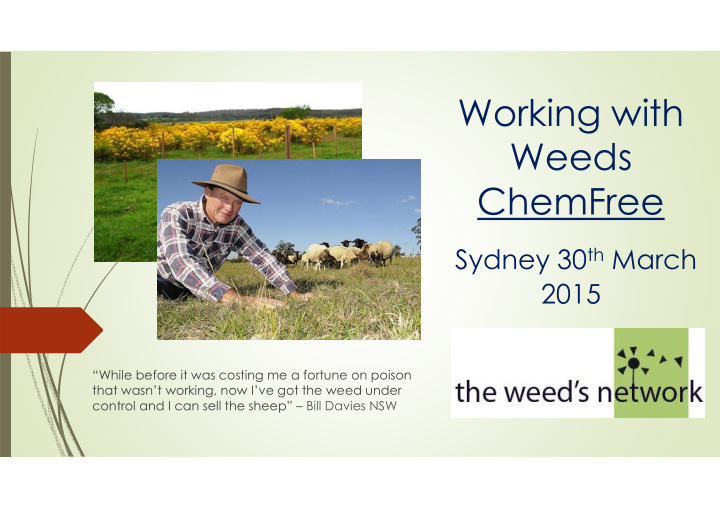



Working with Weeds ChemFree Sydney 30 th March 2015 “While before it was costing me a fortune on poison that wasn’t working, now I’ve got the weed under control and I can sell the sheep” – Bill Davies NSW
Outline � Overview of workshop � Context: you are a limited resource � Nurturing and fostering ecological balance & health � Understanding weeds and the value of ChemFree methods
Personal context: Children about to dig in a site sprayed with glyphosate, Yarra Valley, Victoria.
Institutional context: Monash University, Clayton .
Glyphosate: “probable carcinogen” � This month, 17 experts from 11 countries met in France to assess the carcinogenicity of glyphosate for the United Nations International Agency for Research on Cancer (IARC) – The finding was that glyphosate is a “probable carcinogen”.
Global scope of issue: Global insecticide, herbicide, fungicide, and other pesticide markets over time. Source: Pimental 2014
Financial cost of herbicides Wholesale cost of herbicides Australia – at least A$1.4b pa in Australia (APVMA 2013-14)
Health Cost of illness and injury linked to herbicides and pesticides in small scale farming in sub- Saharan Africa is estimated to be in excess of $A7 billion each year. (UNEP 2012) Health impacts and related health costs from exposure to 133 herbicides and pesticides in European countries (representing about 50% of the herbicides and pesticides applied) found to be A$115 billion each year. (Fantke et al . 2012)
Environmental costs Soil damage Decreased ability to hold water Decreased nutrients & Microbes Erosion & landslides Increased water need Increased fertiliser need
Waterways and wetlands Be careful! Many herbicides can cause damage to waterways and wetlands. Check the herbicide label directions carefully before use near waterways and wetlands. For more information see Guidelines for Safe and Effective Herbicide Use Near Waterways.
Off-site consequences
Loss of forage “Yield losses due to weeds (livestock) – at least A$1.9b”
Soil and crop damage
Equipment, time, labour & energy
Super weeds - resistance Increased use of herbicides increases costs Increased toxicity of herbicides increases health and environmental damage
Compliance costs
Loss of market access
Fighting Weeds With Chemicals Is this the battle you want to take on? Herbicidal “warfare” mentality ... the ‘enemy’ is difficult to control because of the natural vigour and competitiveness of the plant (P&C).
Can we really ‘eradicate’ weeds?
Are weeds really to blame?
Design Rethinking how we do things We know that: weeds love bare & disturbed soil
Partnering with Nature Build ecological resistance by increasing biodiveristy
Goats love to eat weeds
Sheep will eat weeds “While before it was costing me a fortune on poison that wasn’t working, now I’ve got the weed under control and I can sell the sheep” – Bill Davies
Ducks eat weeds
Camels eat weeds The pricklier the better … • Cats claw creeper • Prickly pear • Saffron thistle • Galvanised burr • Lantana (not their first preference) Dean & Tracey Rockemer – Graziers, Booubyjan
Cows eat weeds “We love to eat African Lovegrass” – Local cow, North Burnett, Qld.
Chickens eat weeds Chickens, are known to effectively digest (and destroy) all weed seeds passing through their crops and they can thoroughly graze back vegetation in areas up to one acre in size. Releasing chickens into an area after the mature plants are removed allows them to scratch and peck out weed seeds and potentially reduce the weed seed bank in the soil (Andres 1979).
Grazing Colin Seis - Winona
Urban herbicide pollution reduction
Fostering and nurturing ecological resistance First step to working with Nature is understanding each other. Change of thinking from what one ‘Wants’ to what one can ‘Have’. If you only want sheep but your landscape better supports goats, then you either work with what you Have, or endlessly battle trying to get what you Want.
“ Pick Your Poison ”
Working with nature is easier and achieves desired results
The Weed’s Network
The Weed’s Network: • Strategy for Reducing Herbicide Pollution in Australia • Working with Weeds Guide
Working in harmony “I can see just the change that comes upon us when we make some mental changes in our attitude... what we are doing changes… And it’s pretty rewarding when you can work with the land and the animals and the people in harmony.” (Lindsay 2001, in Rangan, et al., 2013)
Questions …. david.low@monash.edu
Recommend
More recommend